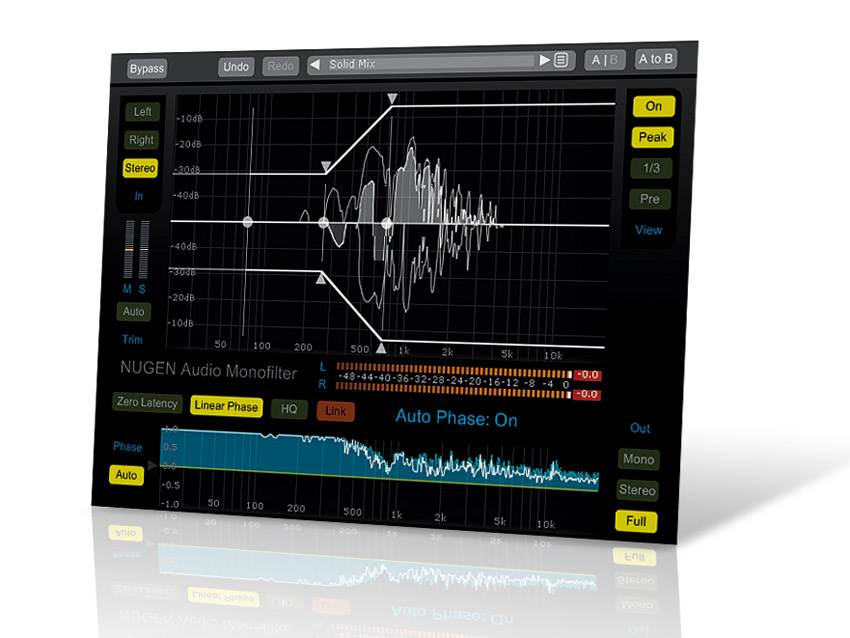MusicRadar Verdict
Typical NuGen attention to detail makes Monofilter 4 a one-stop solution for monoising bass.
Pros
- +
Offers a huge amount of flexibility. Great-sounding linear phase algorithm. Nifty new phase correlation meter. Useful audition modes.
Cons
- -
Linear phase HQ mode uses lots of CPU. Peak hold decays too quickly to be useful. Occasional glitches in Logic.
MusicRadar's got your back
When we looked at v3 of NuGen Audio's Monofilter, it was as part of NuGen's Stereo Pack. Now revamped, Monofilter 4 can still be bought as part of a pack or on its own.
The plug-in's underlying remit is to improve bottom-end definition. This is achieved primarily by reducing the stereo width of the signal below a user-selectable frequency point.
Parameters include image width both below and above this crossover point, control of crossover slope steepness, filter type, automatic and manual L/R phase correlation, processed element monitoring (both mono and stereo), auto level trim, and unlimited undo/redo.
Monofilter 4 includes a far slicker interface, with the main controls now operated by dragging nodes on the main width envelope display. There's also a low-latency filter option, more presets and the ability to switch the algorithm of all plug-in instances simultaneously.
Most significant is the improved visualisation, featuring two types of analyser. View settings include peak hold, a 1/3-octave bar graph and pre-/post-processing. You can use Monofilter just for analysis by configuring neutral settings, and there's a preset to do this for you.
Phased out
The large analyser appearing behind the main width envelope indicates panning by frequency, whereas the lower one indicates phase correlation by frequency. With a mono signal, the analyser will be inactive, showing a straight central line.
However, any difference in levels between the left and right channels (eg, panning) will cause the analysis curve to move up or down at the relevant frequency. Upward movement indicates that the left channel is louder, while downward means the signal is louder on the right.
A signal might be equally loud in the left and right channels, but not necessarily in phase. To this end, the lower window shows phase correlation against frequency. Positive correlations (as the majority of the signal should be) will show above the line (0 to +1). Below the line (0 to -1) indicates instances of uncorrelated left and right channels, and can be useful for spotting phase cancellation problems.
Feel the width
Monofilter 4 offers greater flexibility than most 'bass monoiser' tools - you can reduce the width on a sliding scale and adjust the crossover by moving its upper and lower boundaries, enabling both gradual and sharp transitions.
Narrowing the high frequencies and keeping the lows stereo is also an option, and there are faders for adjusting the levels of the mid and side channels. You can listen to the mono and stereo elements in isolation, and a useful bonus is the integrated high-pass filter for rolling off the bass.
So, what's Monofilter good for? First, it can benefit any mix element with which the lower frequencies are wandering in the stereo image or suffering from phase issues. When used for mastering, it can help you to control the impact of the low end while retaining a decent high-frequency spread.
This can be helpful if your tracks are intended for club or radio play, you plan on cutting to vinyl, or you're mastering problem tracks where you don't have access to the original mix.
It's not magic, though, and the automatic phase correction works best on static or slowly changing differences. The three filter settings (low latency, linear phase and high-quality linear phase) do sound different.
The low-latency option is only really for live use, while the HQ linear phase mode sounds best, though it can be CPU-intensive.
Functional annoyances include the overly quick decay on the frequency peak hold, and periodic audio and visual glitchiness when running under Logic. NuGen Audio is aware of the issues and says they will be addressing them in future updates. Minor moans aside, Monofilter 4 is a handy tool and well worth the upgrade.
Give our audio demo a listen to hear:
1. Stereo synth bass - using the linear phase HQ mode first sweep the high pass filter up and back again. Then adjust the low frequency point and high frequency point to various settings, bypassing to compare - note how the bypassed signal sounds more phasey. Now use the mono and stereo monitoring options to listen as the frequencies are adjusted. Again bypassing to compare.
2. Acoustic drums stereo room mics - adjust the frequency points to various settings to help tighten the low frequencies, bypass to compare at various stages. Pause. Now switch from low latency to linear phase to linear phase HQ modes to hear the difference. Note the timing change as the processing latency varies between modes.
Computer Music magazine is the world’s best selling publication dedicated solely to making great music with your Mac or PC computer. Each issue it brings its lucky readers the best in cutting-edge tutorials, need-to-know, expert software reviews and even all the tools you actually need to make great music today, courtesy of our legendary CM Plugin Suite.
“Built from the same sacred stash of NOS silicon transistors and germanium diodes, giving it the soul – and snarl – of the original”: An octave-fuzz cult classic returns as Jam Pedals resurrects the Octaurus
What’s the buzz? Meet Yellowjacket, Cherry Audio's recreation of EDP’s trend-setting Wasp from 1978
“A fabulous trip through all eight songs by 24 wonderful artists and remixers... way beyond anything I could have hoped for”: Robert Smith announces new Cure remix album











